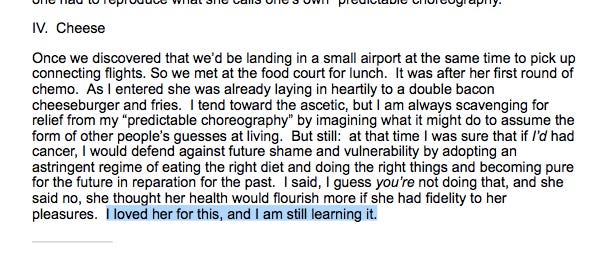A note before we get into it: this week’s newsletter touches upon eating disorders and body image issues. By all means, I would understand if you decided not to read it.
The only thing that rivals my lifelong love affair with food, if I think back, is an equally prevalent body dysmorphia that’s followed me my whole life. Food and its rewards came first, of course, shaping the soft, plump body that condemned me to—at age 7, on my parents’ orders—run laps around a community courtyard in Mississippi while other kids in the neighbourhood chanted “run, fatty, run.” I would return home from a run and be denied ice cream—redirected, instead, to some apples. Kids can be cruel. Adults can be too.
I don’t mean to dig up trauma for spectacle’s sake. I wanted to give you evidence of how far back these feelings go. It’s always been complicated, as I suspect it is for a lot of us. I have gained weight and lost weight and gained it back again, yo-yoing through my teens and twenties and now. I have eaten celery for lunch because Cosmopolitan said it was negative calories, and binged until I made myself sick. When I stand back from all of it, I get this feeling of near-unbearable sadness at the way it played out. One of the purest, brightest sources of joy of my life has always been dulled by a concurrent feeling of self-hatred. That is no way to treat our joys.
To a degree, I have considered myself lucky. Whatever this is—I hesitate to diagnose it or name it at the risk of minimizing more serious conditions—has alway been somewhat manageable. Sure, I restricted and binged and purged on occasion, but I could never resist food for long. I would gain weight, resent it, not do enough about it, then eventually come to love the clothes I bought in my new size. I would adopt ambitious exercise routines and diets and eventually find myself returning to homeostasis. That is where you find me now. It’s still complicated and might be for a long time. But I’m learning to get comfortable.
Part of the change, I think, is in how much more pleasure I derive from food these days. Not just eating it, but thinking about it, learning about it, making it for other people. Cultural context, history, seasonality—all of these aspects of food enhance my enjoyment of it. The other day, I tasted a cherry tomato from my own garden and truly thought it was the best tomato I ever had. These are singular joys, and it changes the playing field. The pleasure is so potent, so remarkable, the body image issues don’t stand a chance. What’s that stupid quote frequently attributed to Kate Moss—nothing tastes as good as thin feels? I stand by the opposite.
Nigella Lawson recently wrote a piece called “An Argument for Culinary Enjoyment” that explores similar terrain. Like I, she would ban the notion of “guilty pleasures” if she could. “What I refuse to live with, categorically and essentially set myself against,” she writes, “is the erosion of pleasure by dint of turning it into a means of self-persecution. “No one should feel guilty about what they eat, or the pleasure they get from eating; the only thing to feel guilty about (and even then I don’t recommend it) is the failure to be grateful for that pleasure.”
It all comes back to gratitude, doesn’t it?
When cultural critic Lauren Berlant passed away at the end of June, my friend J. posted this excerpt of her writing on Twitter. It’s stayed with me, this idea of being loyal to your pleasures. It felt revelatory and radical. I, too, tend to gravitate towards monastic and self-punitive behaviours, the merits of which I have yet to discover. Maybe it’s time, as is the case with the clothes I’ve been holding onto since college, to replace them with something that fits better.
These days I am not far from the heaviest I’ve ever been—scents and tastes have been some of the only saving graces during the pandemic—and for the most part, I am okay with it. But the instinct to deprive is never far. Before I made the katsu for this newsletter, I thought long and hard about whether I “should be eating” something “so rich.” Then my brain did an incredible reframe. If I gain weight, I thought, it would be tangible proof of my pleasure. And that felt like something very much worth experiencing.
A bit about katsu
A few months back I wrote about the origins of Japanese curry, so I won’t do that here. Instead, a few notes on the star of the show: katsu (カツ) is a diminutive of katsuretsu (カツレツ), which is a Japanese transliteration of cutlet, which itself is derived from the French word for a meat chop, côtelette. The connections established here strike matches in my brain. Language is incredible.
Katsu comes in many forms. There’s tonkatsu (not to be confused with tonkotsu, the pork bone broth), which is made from pork. There’s torikatsu, which is made from chicken. You can serve katsu in a katsu curry, katsudon (as in katsu donburi, which is katsu on rice with egg and vegetables), which is not to be confused with a katsu udon, another popular way of serving these golden cutlets.
Recipe notes
I started out with Rick Martinez’s adaptation of katsu curry for Bon Appetit, which looked amazing if a little complicated, so I went back to Sonoko Sakai’s curry recipe (doubling the curry powder, as per her suggestion, for extra curry flavour) and stuck with Rick’s instructions for the katsu itself.
This email marks this newsletter’s first year around the sun! It’s been, well, an immense pleasure.
Until next time,
Tracy






